Mac's Believe It Or Not!
by John McDougald
Reprinted from "Crown Jewels of the Wire", February 2001, page 29
The Bullet
CD 133.4, known as the "bullet" and third in the early Hemingray
line of threaded low voltage styles, has been a popular style for collectors for
many years. It has a lot of history, simply because it was put in service nearly
130 years ago. Since the style was used widely, it has been available, at least
in various shades of aqua, to most collectors, even those on a limited budget.
In addition, the early molding techniques lacked uniformity, creating an
enormous variety of overpours, underpours and other molding flaws that have
become so collectible in recent years. For those with a little more spare
change, Hemingray CD 133.4's come in a wonderful range of colors, mostly in the
blue and green families, enhanced by the milky and amber impurities that were so
often found in these early insulators.
In addition to Hemingray, possibly as
many as five other manufacturers were involved in the production of the CD 133.4
style. Next to Hemingray, the most prolific producer of the CD 133.4 style is
suspected to be the Wormser Glass Company, located in southwestern Pennsylvania.
Wormser produced this style in a wide variety of colors, including purples,
pinks, grays and one known piece in honey amber. Examples of the Wormser style
are shown at the top of page three of the color insert. More about the other
possible manufacturers shortly.
First a bit about the development of the low
voltage styles by Hemingray. The early style numbers were just shown as numbers
on the back of the crown. The "old" Hemingray number "1" is
classified as CD 131.4 and this insulator has the same profile as its threadless
counterpart, CD 732.2. We know that Hemingray was in the business of producing,
at least on an experimental basis, threadless insulators because a few examples
with the December 19, 1871 date have been found employing the Floyd patent
threadless pinhole. The colors of unembossed CD 732.2's are consistent with
Hemingray, but that production has not been attributed to Hemingray with any
level of assurance. Examples of CD 131.4 and CD 732.2 (using the Floyd patent)
are pictured on the following page.
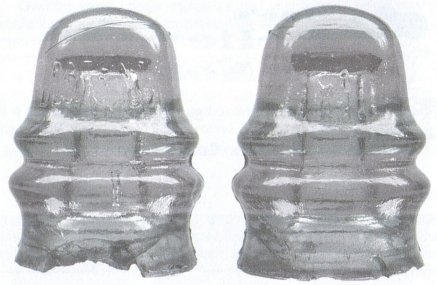
A threadless CD 732.2 (Floyd patent) with PATENT over
DEC. 19 1871 on front
crown and a large "1" on the rear crown.
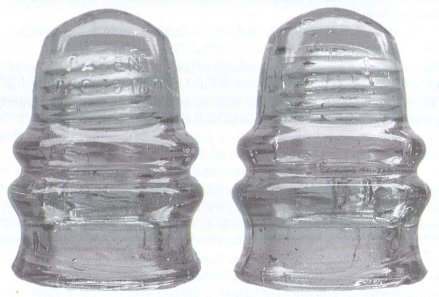
CD 131.4 with PATENT over DEC. 19 1871
on front crown and a large
"1" on the rear crown.
The "old" Hemingray number "2" is classified as CD 132.
Again, Hemingray was the predominant manufacturer of this style, but there may
be as many as three other manufacturers, none of whom have been identified with
certainty. CD 132's by Hemingray and one of the unattributed manufacturers are
pictured below.
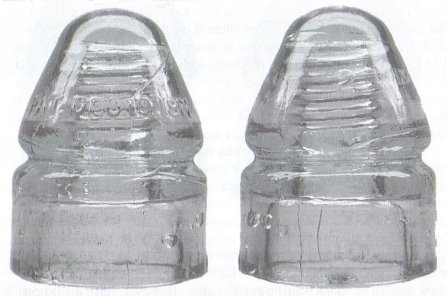
CD 132 with PATENT DEC. 19 1871 one line embossing
on front crown and a large
"2" on the rear crown.
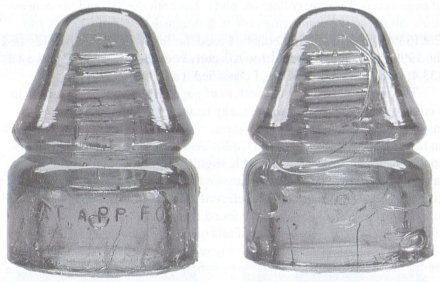
CD 132 with PAT APP FOR on front skirt and
a large "2" on the rear
skirt.
The "old" Hemingray number "3" is the CD 133.4 shown in
the color insert. It appears to be a scaled down version of the CD 132, slightly
shorter and narrower but with the same basic characteristics.
One of the
perplexing issues that arises with the "old" Hemingray number
"3" style is its range of shapes. The first two pages of the color
insert highlight this problem. Ordinarily, we could just deal with it noting the
variations in shapes, but the problem is compounded because of the difficulty
that many collectors have in assigning CD's to insulators in the CD 133-134
range. Here is the problem with the Hemingray pieces. CD 133.4 is designed to
have a convex crown. In other words, if you place a straight edge on the crown,
it will only come in contact with one point on the crown surface at a time
because it is rounded outward. The examples shown on page one of the color
insert are typical.
However, on page two of the color insert, you see examples
(in the middle of the page) of bullets whose crown sides are virtually flat and
(at the bottom of the page) of bullets with concave crowns. The profile shown at
the bottom of page three is virtually identical to CD 133, whose primary
characteristic is a concave crown. I originally solved this problem by
classifying all of the bullets that didn't have a "3" on the rear
crown as CD 133's and all with a "3" on the rear crown as CD 133.4's.
That was consistent with the small sample of bullets without "3's"
that I had seen, most notable of which was the purple bullet. However, since my
original decision, I have seen a number of bullets with "3's" on the
rear crown and concave crown shapes. The emerald green example shown at the
bottom of page two is from my collection, and it has both the "3" and
the concave skirt. So if you are wondering how to distinguish between CD 133 and
CD 133.4 when classifying bullets, I used the following rule when I issued the
1999 Price Guide: If the crown is convex or flat, I classified it as a CD 133.4;
if the crown is concave, I classified it as a CD 133.
The pieces pictured at the
bottom of page three don't really represent a controversy, just another of the
many unanswered questions in the insulator hobby. On the left is a Wormser
attributed bullet. On the right is an insulator that I acquired from Collin
Yennie at one of the local Minneapolis shows several years ago. It is slightly
larger than the Wormser (about 1/8" at the base), and you can see that the
profile near the wire groove is quite different. Collin believed that the piece
was manufactured in Canada as several of them were found in service there, but
no more details are available. I wondered if this piece was the listing that I
had classified as a CD 132, but because my records from the '91 Price Guide are
not computerized, I was unable to verify the source of that information in time
for this article. Strictly from a size standpoint, it is a "tweener",
but it is a little bit closer to a CD 133.4, so for now, I'm going to leave it
there.
The CD 133.4 Bullets
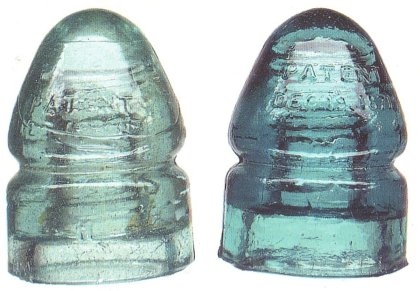
This is the traditional rounded shape of the CD 133.4 bullet made by
Hemingray. The front crown is embossed PATENT / DEC. 19. 1871 and the rear crown
is embossed with the number 3. The left bullet has a single [Letter] on the
front skirt and the right bullet has a single [Letter] on the rear skirt. Some
letters can have a backwards engraving, as is the case with the right bullet.
Two other embossing variations are bullets that have no skirt [Letter] and one
where the middle bar is missing in the letter "E" of DEC.
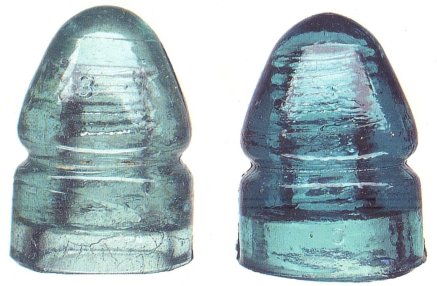
Many of the early Hemingray bullets are misshapen due to base overpours and
underpours, some are filled with steam, milky swirls and irregular bubbles.
This example has a two inch long bubble around the lower crown of the insulator
just above the wire groove.
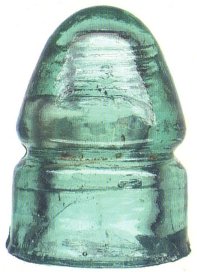
Two other Hemingray dome mold varieties are the smooth, angular mold shown
below. . .
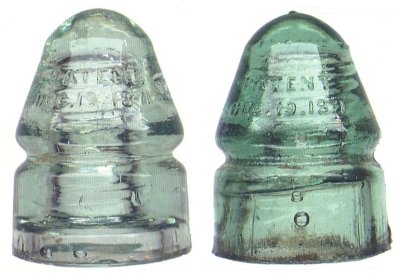
. . . and the concave mold which gives this bullet the appearance of a
typical CD 133 shape. Hemingray products definitely provided style with a lot of character.
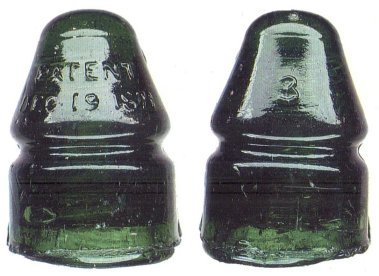
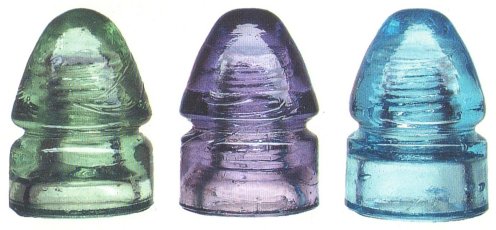
The Wormser Glass Company located in southwestern Pennsylvania has often been
mentioned as the possible manufacturer of the unembossed CD 133.4 bullets with
the smooth, clean lines and well defined wire ridge and groove. The variety of
colors in this bullet style are numerous.
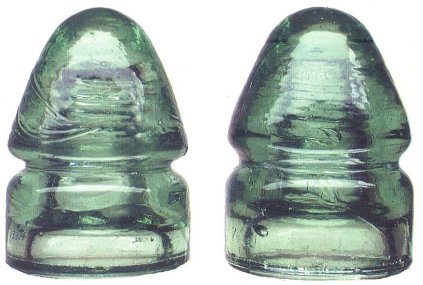
Another unembossed piece, with suspected Canadian origins (right) is similar
to the Wormser style (left), but has a more rounded wire ridge and groove.
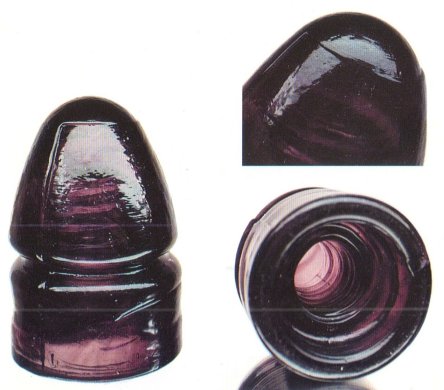
Listed as the unembossed West Virginia style in the 1999 Price Guide for
Insulators, these bullets have a very strong side seam and strong button mold.
However, they do not resemble the more traditional three-piece mold style of the
early Hemingray products. The purple, teal and cobalt blue colors are pictured.
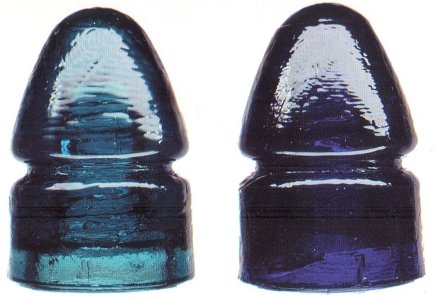
Two other uncommon styles of CD 133.4 have been verified to date. The first
is another unembossed style, but it is distinguished from the Wormser piece
because it is MLOD (mold line over the dome, which indicates that it was
manufactured in a two piece mold rather than a three piece mold). To the best of
my knowledge, only a few of these have been found, and their manufacture is
unattributed. Another interesting bullet is the base embossed style. It is
distinguished by a very flat base on which PAT'D is weakly embossed. Although
this style remains quite rare, it is found in an amazing variety of colors. Most
of the colors are in the green and aqua family, but examples in purple/sage two
tone and cobalt blue have been found. Again, to the best of my knowledge, the
manufacturer of this piece is unknown, although there are two other styles (CD
102 and CD 132) with the same characteristic weak embossing that appear to be
from the same manufacturer.
The story of the CD 133.4 bullet would not be
complete without the mention of the West Virginia bullet. These insulators
surfaced about 10 years ago and immediately raised controversy. On page four of
the color insert, you can see pictures of the three exotic colors that this
particular style was found in. In addition, a few examples were found in a green
aqua and a near clear. The distinguishing characteristics of this piece include
a button mold, a fairly pronounced crown seam (both pictured on the color
insert) as well as rather weak threading in the pinhole. As a concerned
collector as well as the chairman of the Research and Authentication Committee
of the NIA, I have spent a great deal of time investigating these pieces in an
effort to establish their legitimacy. I have interviewed all of the principals
in the discovery, I have walked the line on which they were discovered on two
separate occasions, and I submitted samples for chemical analysis as part of the
NIA research project several years ago. For me personally, the jury is still
out. The mention of these insulators and the controversy that surrounds them is
not with the intention of "stirring the pot" one more time, because I
believe that most collectors who are aware of the controversy have made up their
minds one way or another. This information is provided so that those collectors
who are not aware that there even is an issue can be informed and draw their own
conclusions. I still get occasional calls/E-mails from collectors who want
information regarding the West Virginia bullets, and this information is
provided for them.
Well, that's the CD 133.4 story as far as I know it. If you
want to share any additional information regarding this or any other style
insulator, please contact me by letter, phone or E-mail. I'm looking for new
stories to include in future installments of Mac's Believe It or Not!
| 